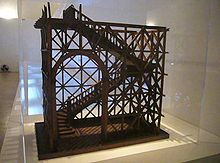Gaiola (construction)
This article needs additional citations for verification. (October 2017) |

A gaiola pombalina (Pombaline cage; Portuguese pronunciation: [ɡɐjˈjɔlɐ], "cage") is a masonry building reinforced with an internal wooden cage, developed as an anti-seismic construction system in Portugal after the 1755 Lisbon earthquake and implemented during the reconstruction of Lisbon Baixa (Lisbon downtown).[1]
The catastrophic event of 1755 showed the fragility of the masonry construction, which are not able to absorb and dissipate the energy released by the earthquake. The three-dimensional wooden structure was inspired by construction methods in shipbuilding. The wood, being deformable, had a high capacity of resistance to the forces of traction and compression in a constantly agitated medium.
Since masonry is more effective in resisting fires incorporating the wooden structure in masonry walls combined the advantages of both types of construction.
See also
References
